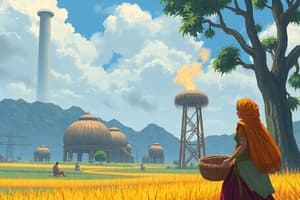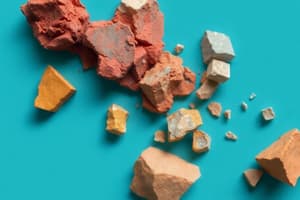Podcast
Questions and Answers
Right from the ancient times in India and even today, for religious ceremonies they use ______, brass and so on
Right from the ancient times in India and even today, for religious ceremonies they use ______, brass and so on
copper
Copper wires were used for ______ instruments
Copper wires were used for ______ instruments
stringed
Utensils made of ______; because sanctity was attached to it
Utensils made of ______; because sanctity was attached to it
copper
One a colossal copper statue of Buddha about seven and a half feet in height about a ton was discovered at Sultan Ganj in the district of Bhagalpur, in the ruins of the old Buddhist Monastery; which means it should be maybe about 2000 ______
One a colossal copper statue of Buddha about seven and a half feet in height about a ton was discovered at Sultan Ganj in the district of Bhagalpur, in the ruins of the old Buddhist Monastery; which means it should be maybe about 2000 ______
All these show that copper and its alloys were in great ______
All these show that copper and its alloys were in great ______
So, either you come from the one side which is you know cast iron side, in which case you have to remove ______ or you come from the wrought iron side in which case you have to ______.
So, either you come from the one side which is you know cast iron side, in which case you have to remove ______ or you come from the wrought iron side in which case you have to ______.
Another statue 80 feet high was reportedly witnessed by the Chinese traveller Hiuen Tsang near Nalanda, in a Vihara of ______ constructed by King Shiladitya
Another statue 80 feet high was reportedly witnessed by the Chinese traveller Hiuen Tsang near Nalanda, in a Vihara of ______ constructed by King Shiladitya
These are the two methods normally for ______.
These are the two methods normally for ______.
The second process which is using the carburizing the wrought iron; that process was discovered in ______ only in the 18th Century CE.
The second process which is using the carburizing the wrought iron; that process was discovered in ______ only in the 18th Century CE.
The iron produced by the Indian method is always ______ iron, unlike cast iron which is produced in © All Rights Reserved.
The iron produced by the Indian method is always ______ iron, unlike cast iron which is produced in © All Rights Reserved.
On the other hand, Indian iron was prepared by this process from ______.
On the other hand, Indian iron was prepared by this process from ______.
Therefore, the ferrous carbon alloy that Indians made were always from the ______ iron.
Therefore, the ferrous carbon alloy that Indians made were always from the ______ iron.
All ancient civilizations were hooked onto this ______ business.
All ancient civilizations were hooked onto this ______ business.
Alchemists were involved in extracting ______ for their alchemical preparations.
Alchemists were involved in extracting ______ for their alchemical preparations.
The metal working engineers engaged on a bigger scale were sort of nearly an ______ scale kind of operation.
The metal working engineers engaged on a bigger scale were sort of nearly an ______ scale kind of operation.
Rasa-Ratna-Samuccaya described a variety of crucibles and furnaces for the manufacture of ______ medicines.
Rasa-Ratna-Samuccaya described a variety of crucibles and furnaces for the manufacture of ______ medicines.
Alchemists thought that you can take a metal and convert it into ______.
Alchemists thought that you can take a metal and convert it into ______.
Alchemists travelled quite a bit on ______ and Material Science.
Alchemists travelled quite a bit on ______ and Material Science.
There are cannons found at Narwar, Musheerabad, the Dhaka in Bangladesh, Bishnupur, Bijapur, Gulbarga, and Thanjavur which all provide ample evidence to the medieval Indian blacksmith skill in the design, engineering, and construction of large force forge welded iron objects. These cannons are a testament to Indian proficiency in ____________.
There are cannons found at Narwar, Musheerabad, the Dhaka in Bangladesh, Bishnupur, Bijapur, Gulbarga, and Thanjavur which all provide ample evidence to the medieval Indian blacksmith skill in the design, engineering, and construction of large force forge welded iron objects. These cannons are a testament to Indian proficiency in ____________.
Prof.B.Mahadevan authored the document permitted for use only within the course 'Indian Knowledge System (IKS)- Concepts and Applications in Engineering' delivered in the online course format by IIM Bangalore. No part of this document may be reproduced without the prior permission of the ____________.
Prof.B.Mahadevan authored the document permitted for use only within the course 'Indian Knowledge System (IKS)- Concepts and Applications in Engineering' delivered in the online course format by IIM Bangalore. No part of this document may be reproduced without the prior permission of the ____________.
Sushruta Samhita, dating back to the 2nd Century BCE, describes a sample set of tools made of Fe-C alloys used for surgical purposes. The fabrication process involved heat treatment to achieve a ____________ edge.
Sushruta Samhita, dating back to the 2nd Century BCE, describes a sample set of tools made of Fe-C alloys used for surgical purposes. The fabrication process involved heat treatment to achieve a ____________ edge.
The design, engineering, and construction of the cannons found at Narwar, Musheerabad, the Dhaka in Bangladesh, Bishnupur, Bijapur, Gulbarga, and Thanjavur showcase the Indian proficiency in working with ____________ objects.
The design, engineering, and construction of the cannons found at Narwar, Musheerabad, the Dhaka in Bangladesh, Bishnupur, Bijapur, Gulbarga, and Thanjavur showcase the Indian proficiency in working with ____________ objects.
The document authored by Prof.B.Mahadevan is exclusively permitted for use within the course 'Indian Knowledge System (IKS)- Concepts and Applications in Engineering' offered online by IIM Bangalore. It prohibits reproduction of any part of the document without the prior consent of the ____________.
The document authored by Prof.B.Mahadevan is exclusively permitted for use within the course 'Indian Knowledge System (IKS)- Concepts and Applications in Engineering' offered online by IIM Bangalore. It prohibits reproduction of any part of the document without the prior consent of the ____________.
Sushruta Samhita mentions the fabrication of over 100 surgical tools made of Fe-C alloys. These tools were created with the intention of achieving a ____________ edge through heat treatment.
Sushruta Samhita mentions the fabrication of over 100 surgical tools made of Fe-C alloys. These tools were created with the intention of achieving a ____________ edge through heat treatment.
This document has been authored by Prof. B. Mahadevan and is permitted for use only within the course 'Indian Knowledge System (IKS)- Concepts and Applications in Engineering' delivered in the online course format by IIM Bangalore. No part of this document, including any logo, data, illustrations, pictures, scripts, may be reproduced, or stored in a retrieval system or transmitted in any form or by any means – electronic, mechanical, photocopying, recording or otherwise – without the prior permission of the ________.
This document has been authored by Prof. B. Mahadevan and is permitted for use only within the course 'Indian Knowledge System (IKS)- Concepts and Applications in Engineering' delivered in the online course format by IIM Bangalore. No part of this document, including any logo, data, illustrations, pictures, scripts, may be reproduced, or stored in a retrieval system or transmitted in any form or by any means – electronic, mechanical, photocopying, recording or otherwise – without the prior permission of the ________.
Indian Knowledge System (IKS) – Concepts and Applications in Engineering Prof. B. Mahadevan Week 06_Clip 06 Lost wax casting of idols and artefacts. So far we saw how Indians were able to extract zinc, copper, iron and then process many alloys and so on. Now, in this video, let us see what did they do with all these ________.
Indian Knowledge System (IKS) – Concepts and Applications in Engineering Prof. B. Mahadevan Week 06_Clip 06 Lost wax casting of idols and artefacts. So far we saw how Indians were able to extract zinc, copper, iron and then process many alloys and so on. Now, in this video, let us see what did they do with all these ________.
One particular application that we will see is called Lost Wax Casting of ________ and artifacts.
One particular application that we will see is called Lost Wax Casting of ________ and artifacts.
A lot of temples, particularly Chola period in Tamil Nadu, have gods and goddesses with very nice iconography, statues made of ________ and so on.
A lot of temples, particularly Chola period in Tamil Nadu, have gods and goddesses with very nice iconography, statues made of ________ and so on.
This process is called “Madhuchista Vidhana”; see madhu is honey, ucchista is what is left out. So, it is actually the wax after the honeybee is gone, what is left out is the ________.
This process is called “Madhuchista Vidhana”; see madhu is honey, ucchista is what is left out. So, it is actually the wax after the honeybee is gone, what is left out is the ________.
Vidhanam is the ________.
Vidhanam is the ________.
Flashcards are hidden until you start studying




